The features of a courtroom help set the tone for the proceedings that take place within its walls. This article examines the design features that can make a courtroom feel user-friendly rather than intimidating and how a user-friendly courtroom might best support justice in a trial.
The Basis for a Welcoming Courtroom
The rule of law has two objectives:
(1) encouraging law-abiding behavior, and
(2) ensuring fairness in the judicial system.
For the courthouse architect, the second objective means that the courthouse, particularly the courtroom, must be welcoming and user-friendly for the civil litigants, jurors, spectators, witnesses, and even attorneys – after all, they are human, too.
You may have noticed that I left out criminal defendants. Admittedly, it is hard to make a case for a courtroom being user-friendly for a twice-convicted drug dealer. So, I won’t even try. I suspect some criminal defense attorneys, like the one described in the recent article about imposing courtrooms, might want to make this case. I do not doubt that this attorney would disapprove of the historic courtroom in the following photo. That was obviously not designed to make the criminal defendant feel comfortable. However, I will leave this issue to the judgment of the reader.
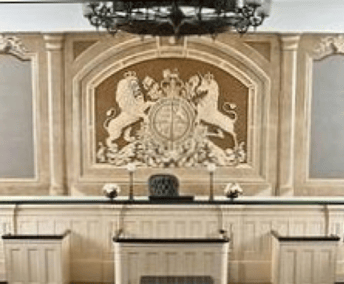
Comforting to a Criminal Defendant?
Courtroom Function
The functional design features of a courtroom may include characteristics such as:
· comfortable seating
· easy-to-read evidence displays
· proper acoustics
· balanced climate control
· adequate lighting
· appropriate handicapped access
· A spacious and safe layout that avoids unwanted public/defendant interaction
The first six characteristics all have one thing in common – they focus on physical comfort. The emotional stress of a trial need not be multiplied by physical stress. Providing physical comfort can reduce and perhaps eliminate the emotional tension often found in trial proceedings, leading to well-thought-out and potentially better verdicts.
The final characteristic is also important in eliminating stress for public participants, ensuring the safety and security of all participants, and a fair verdict.
These basic functional design features are almost always incorporated into the design of new courtrooms. They are objective and transparent. The qualitative design features could be more straightforward and merit more attention.
Courtroom Character
To consider courtroom character, let’s go back to several of the qualitative design characteristics I noted in my earlier blog on user-friendly courthouse exteriors. These four design characteristics – scale, materials, symbolism, and decorative attributes – are also applicable to creating a user-friendly courtroom. Let’s look at each of them individually.
Scale
Most court jurisdictions have standards for the size and height of courtrooms serving the various functions within that jurisdiction. The size standards ensure adequate space in the well and spectator seating area and proper separation between criminal defendants and other trial participants. The height standards allow for a raised judge’s bench and clear visibility between trial participants. But these relate to functionality, not aesthetics.
From the ancient Greek concept of the golden ratio embraced by 20th-century architect Le Corbusier to the Chinese balance concept of Feng Shui, scale and proportion have been regarded as essential considerations in determining the quality of interior space: not too narrow, not too wide, not too high, not too low.
For example, a vertically spacious, light-filled interior with balanced proportions is considered far superior to a darker, cramped space with low ceilings for promoting the kind of focus and attention required in a trial. Just consider the two courtrooms pictured below. Which one would help you think more clearly?
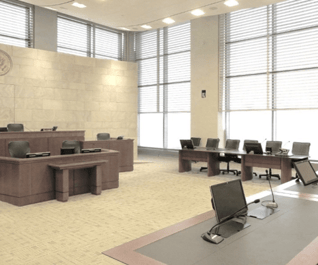

Promoting Clear or Stifled Thinking?
Materials
Materials also play a critical role in establishing your perception of an interior space as well as your perception of a building exterior. The authoritative formality of traditional dark mahogany wood panels and furniture versus the informality of light-colored fabric walls and furniture is a significant contrast, as depicted in the two courtrooms pictured below. Which one is more welcoming?
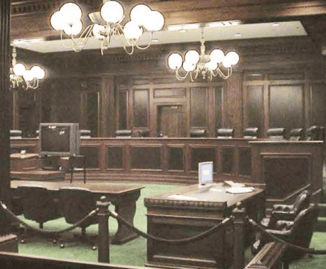
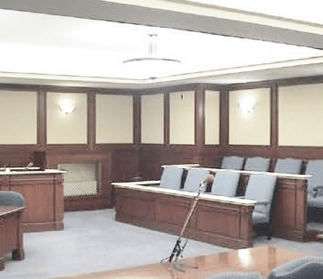
Formal Versus Informal
Symbolism
The seal above a judge’s bench may also serve as a potentially intimidating symbol of authority, similar to the traditional Greek columns on the exterior of a courthouse. Contrast the first photo showing a prominent jurisdictional seal with the second photo showing a judges’ bench in a family court free from symbolism. Perhaps symbolism has its uses in courtrooms emphasizing criminal trials, but not in a family court that seeks to be more welcoming in character and less stressful for the trial participants.


Symbolism May Have its Place in Some Courts, but Not All
Decorative Attributes
Decorative attributes include color, texture, and art. These characteristics can significantly affect the overall impression of a courtroom interior, making it more somber and intimidating or cheery and user-friendly. The minimal use of heavy opaque materials, the greater use of bright colors, and the application of contemporary art forms can all help create a more welcoming courtroom interior.
The bright colors of the courtroom art depicted in the following photo unquestionably attempt to convey a welcoming and user-friendly message – and perhaps alleviate the inherent stress of a trial.
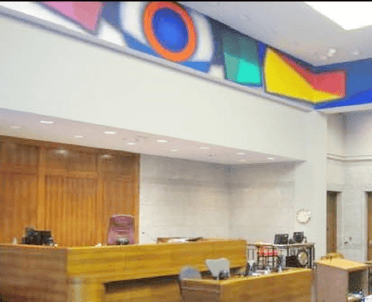
A Welcoming and User-Friendly Message
A Balancing Act
Can today’s courtrooms accommodate the two objectives of the rule of law? Can they promote the need for law-abiding behavior while appearing welcoming and user-friendly? As with any qualitative design aspect, achieving these two objectives is not always cut-and-dry – not something standards can dictate.
In my experience, achieving a balanced approach to these objectives requires the commitment of the court jurisdiction, combined with the careful attention of the courthouse architect.
The court must first believe in the concept of a welcoming and user-friendly courtroom and actively promote this concept in how it conducts its trials. Only then can the courthouse architect develop designs that support and encourage this concept. To paraphrase Frank Lloyd Wright, the form must follow a function.
Still, balancing promoting the need for law-abiding behavior and being welcoming and user-friendly will require skill and perhaps some subtlety. I just wanted to let you know that it can be done.
_________________________________________________
Click the image below to download our courtrooms and chambers eBook.



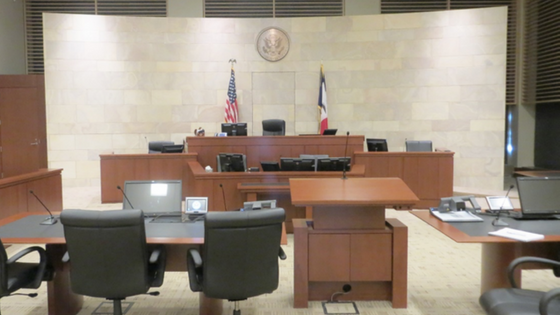
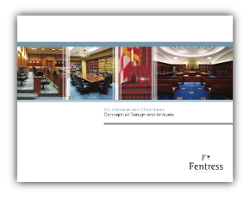
.jpg)
.jpg)
.jpg)
.jpg)
.jpg)
.jpg)


.jpg)
.jpg)
-1.jpg)
.jpg)
.jpg)
.jpg)
.jpg)
.jpg)

